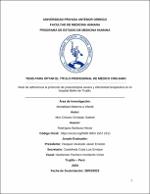Nivel de adherencia al protocolo de preeclampsia severa y efectividad terapéutica en el hospital Belén de Trujillo

View/
Download
(application/pdf: 457.8Kb)
(application/pdf: 457.8Kb)
Date
2023Author(s)
Mori Chávez, Christian Gabriel
Metadata
Show full item recordAbstract
Determinar si el nivel de adherencia al protocolo terapéutico de
preeclampsia severa influye sobre la efectividad del tratamiento en pacientes del
Hospital Belén de Trujillo.
Material y métodos: Se llevó a cabo un estudio analítico, transversal en el que
se incluyeron a 113 gestantes con preeclampsia severa, según criterios de
selección los cuales se dividieron en función de la presencia o no de efectividad
terapéutica, se calculó el chi cuadrado y el estadígrafo odds ratio.
Resultados: La edad gestacional mayor o igual a 37 semanas, multiparidad e
índice de masa corporal menor a 30 fue más frecuente en el grupo de pacientes
con preeclampsia severa en quienes se alcanzó la efectividad terapéutica
(p<0.05), el nivel de adherencia al protocolo terapéutico de preeclampsia severa
en gestantes fue: bueno (24%); regular (68%) y malo (08%). el costo promedio
del tratamiento de preeclampsia severa fue de 200.0 soles con una desviación
estándar de 138.3, existe asociación entre el nivel de adherencia al protocolo
terapéutico de preeclampsia severa y ausencia de complicaciones en gestantes
(p<0.05), existe asociación entre el nivel de adherencia al protocolo terapéutico
de preeclampsia severa e ingreso a UCI ≤ 3 días en gestantes (p<0.05); en el
análisis multivariado se identifican a las variables: edad gestacional mayor o igual
a 37 semanas, Multiparidad e índice de masa corporal menor a 30 como factores
asociados a efectividad del tratamiento en pacientes con preeclampsia severa.
Conclusión: El Buen nivel de adherencia al protocolo terapéutico de
preeclampsia severa influye sobre la efectividad del tratamiento en pacientes del
Hospital Belén de Trujillo To determine if the level of adherence to the therapeutic protocol for
severe preeclampsia influences the effectiveness of treatment in patients at
Hospital Belén de Trujillo.
Material and methods: An analytical, cross-sectional study was carried out in
which 113 pregnant women with severe preeclampsia were included, according to
selection criteria which were divided according to the presence or absence of
therapeutic effectiveness, the chi square was calculated and the odds ratio
statistician.
Results: Gestational age greater than or equal to 37 weeks, multiparity and body
mass index less than 30 were more frequent in the group of patients with severe
preeclampsia in whom therapeutic effectiveness was achieved (p<0.05), the level
of adherence to the therapeutic protocol of severe preeclampsia in pregnant
women was: good (24%); regular (68%) and bad (08%). the average cost of
treatment for severe preeclampsia was 200.0 soles with a standard deviation of
138.3, there is an association between the level of adherence to the therapeutic
protocol for severe preeclampsia and the absence of complications in pregnant
women (p<0.05), there is an association between the level of adherence to the
therapeutic protocol for severe preeclampsia and ICU admission ≤ 3 days in
pregnant women (p<0.05); In the multivariate analysis, the variables were
identified: gestational age greater than or equal to 37 weeks, multiparity and body
mass index less than 30 as factors associated with treatment efficacy in patients
with severe preeclampsia.
Conclusion: The level of adherence to the therapeutic protocol for severe
preeclampsia Good influences the effectiveness of treatment in patients at
Hospital Belén de Trujillo
Subject
Collections
- Medicina Humana [2969]

